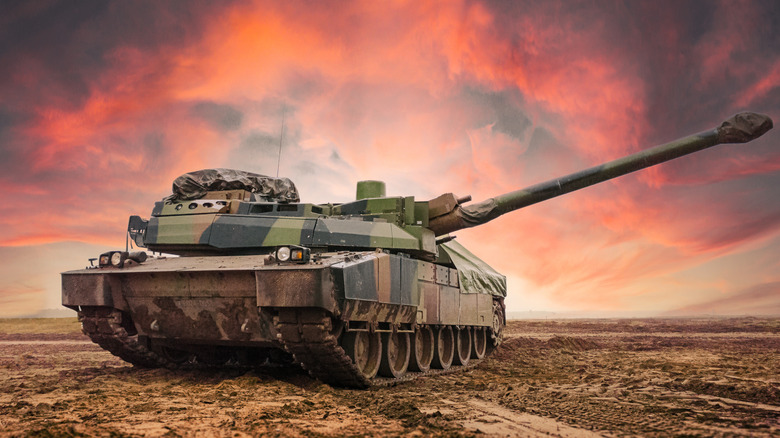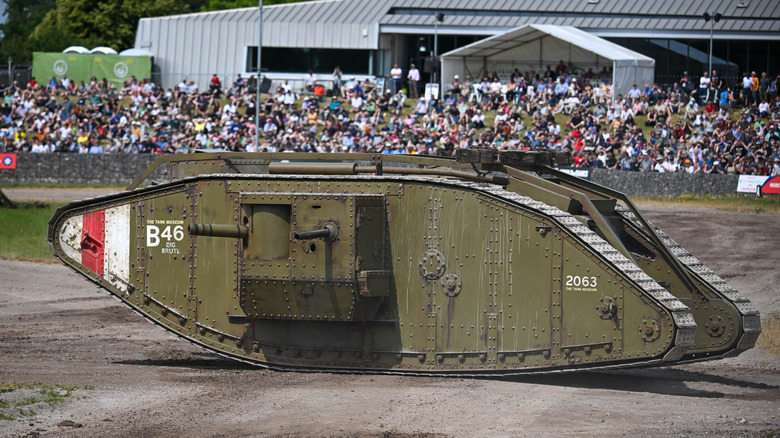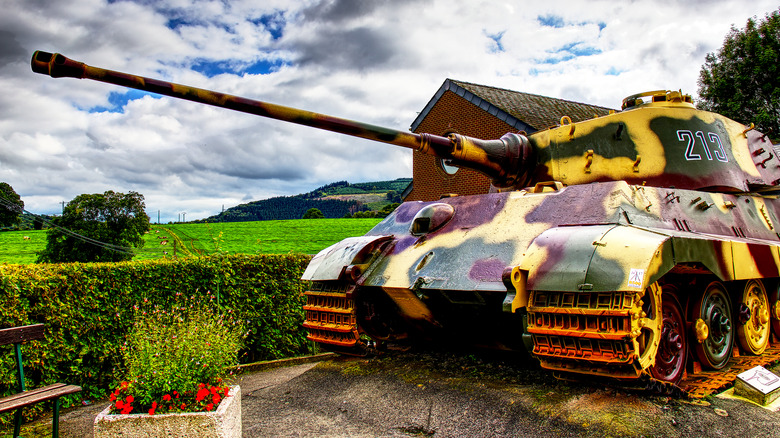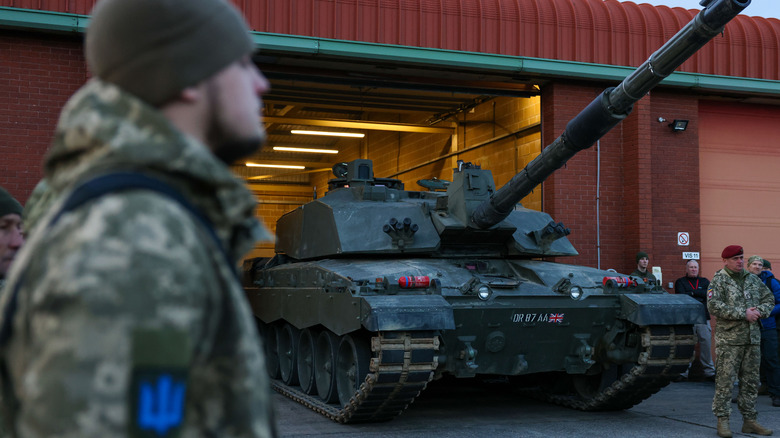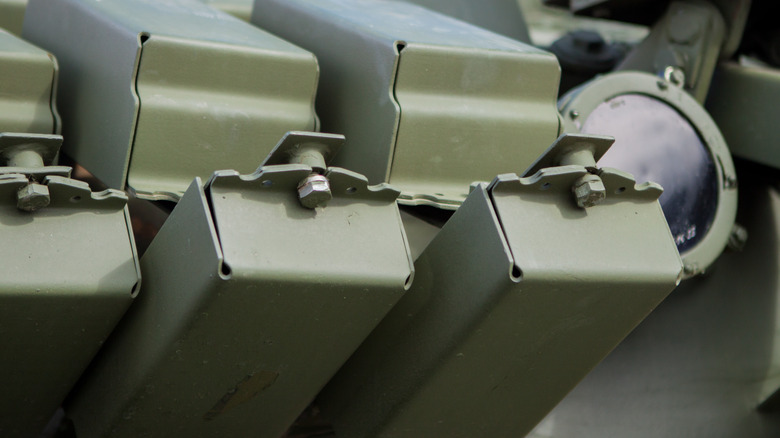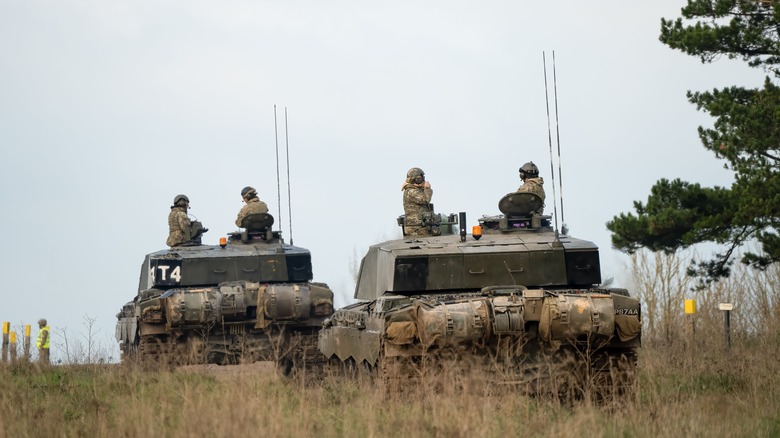Here's How Tanks Deflect Bullets And Shells
The first functional tank ever built was the venerable Little Willie, constructed in 1915 by the British William Foster & Co. It was not designed for combat, but rather as a proof of concept. The Landships Committee, led by Winston Churchill, was seeking a way to break the defensive deadlocks that were an inevitability of trench-digging tactics. Assaults on opposing trenches could and did result in enormous losses, so part of the logic was this: If individual soldiers couldn't be clad in armor, how about a charge led by a vehicle that was?
The first tanks were great, cumbersome machines. Discussing Little Willie in an episode of "The Tank Museum's Tank Chats" series, David Fletcher notes that it was fitted with "a huge differential system for steering ... the people in the tank ... had enormous levers to pull on just to try [with a great emphasis on the 'try'] to get the thing to go around corners." It's safe to say, then, that the first tanks attracted a great deal of attention from the enemy — and struggled to deftly avoid that attention once it was directed at them. Over time, huge leaps in defensive technology have allowed them to perform better under fire.
Let's take a look at the development of tank armor and how it works to boost the survivability of the machines by dampening and deflecting the impact of bullets and artillery shells.
What was early tank armor made from?
David Willey explains in "The Tank Museum's Tank Chats Reloaded" series that Little Willie's body is "all riveted to angle iron. It's not actually armor plate, it's just standard steel or what was called at the time boiler plate." It was not a combat vehicle — more a test of the metal-body-on-treads concept that would soon hit the battlefields of World War I. The basic components were there, though, and they say a lot about the priorities for tank armor in the machines' earliest guises.
Willey goes on to state that 10 mm armor plating was planned to be used in place of the boiler plate if the design was going to be used as a combat tank. Steel armor plating, then, was an early priority with tank armor. The Mark I tank — the first to be used in battle, in September 1916 — boasted 12 mm thick armor plating of this type. These defenses were largely impenetrable to standard rifle fire at the time, but they had no capacity to deflect the impact of heavier blows. Intimidating a weapon as they were, the first British tanks were soon found to have a vulnerability to explosives like hand grenades and artillery, as well as more powerful guns equipped with 7.92 mm armor-piercing bullets. The shock of facing this new tread-driven weapon, then, was soon supplanted with armaments and strategies to destroy it. Something had to change.
Development in the face of more advanced anti-tank weapons
Throughout World War II, tank technology developed to an astonishing degree. The King Tiger, or Konigstiger to its German creators, was one of the most sophisticated armored vehicles the world had yet seen on its arrival in 1944, late into the war. Weighing just below 70 tons, it boasted armor of around 180 mm thick. This was rather traditional armor plating, but its thickness and sloping design set it apart in a new way.
During the conflict, tank designers developed a new approach. It wasn't just about creating the heaviest plate practical to install, but implementing it in a way that would help reduce the impact of shells and bullets. Armor mounted at an angle — while more complex to develop and not a practical or necessary option for every tank of the time — was a brilliant yet simple defensive innovation. It effectively makes armor "thicker" when struck by horizontally-approaching ordnance. According to Tank Historia, 100 mm armor mounted at a 40-degree angle has the strength (in the face of a strike) of 141 mm.
The angle can also potentially deflect a shot from the path it would have taken or damage and disperse its force on impact. These elements were a good fit for combating the more insubstantial anti-tank artillery available at the time, but as such weapons developed, developers focused more on composite armor.
The introduction of composite armor
Sloped armor essentially makes use of additional space to bolster the defenses of a vehicle. Composite armor implements multiple different types of materials to a similar effect. This became necessary in the light of new types of anti-tank armaments, such as the shaped-charge missiles that were not so easily diverted from the steely hulls of their targets. Weapons such as these employed chemical energy, handily sidestepping the weakness of kinetic energy armaments (which had to become progressively bigger to maintain the level of force needed to impact improved armor).
Tank designers, then, turned to composite armor. The concept was simple: Thick metal has formed the primary defense of tanks for decades, and the addition of something in between layers of such could further increase armor effectiveness. What was the filling in the defensive Oreo? In the case of Chobham armor — developed by the British in 1965 — a layer of hardened ceramic material was used in tandem with titanium and steel. Further developments of this secretive armor have rendered it incredibly resistant, to the point that certain areas of the tank are all but impenetrable except at optimum angles and ranges. Such shielding is even effective against anti-tank HEAT shells and has been utilized in tanks such as those from the Challenger family, models known as having formidable defenses.
Another sophisticated type of tank armor doesn't just absorb blows or deflect them — it explodes right back.
The function of reactive armor
Generally, from their very introduction, tanks have been defined by their ability to easily withstand smaller blows. During World War I, as we've seen, the first tanks were combated primarily through the explosive impact of artillery. Later, engineers found a way to turn the great power of an explosion into a tank's defense too.
The Soviet Union's Scientific Research Institute of Steel first discussed the concept of reactive armor in 1949, but it wasn't until 1970 that a patent for such was acquired by Norway's Manfred Held. The idea was developed into the Blazer armor, and Israel used it on its tanks in the 1982 Lebanon War. The result was another enormous leap forward for tank protection.
Reactive armor is a sort of protective vest around a vehicle, consisting of compartments of small explosive devices. When struck by a missile, it "cancels out" some of the force by delivering its own force in the opposite direction. This shielding is effective at both destroying kinetic energy shells and dramatically reducing the impact of high explosive anti-tank missiles (by effectively forcing an "early" detonation). Indeed, Forbes reports that explosive reactive armor can render a tank around twice as resistant to such impacts. It isn't generally to be used on certain lightly armored vehicles, however, as the armor's explosive force can pose a threat to such machines.
Both tank and anti-tank technology continue to evolve
Over a century after they were first used, tanks can be as potent a force in battle as they've ever been. This is because they have continued to evolve. So too, then, have the weapons designed to fight back against them. Throughout the early 1940s in World War II alone, the British-developed anti-tank gun grew from the 130-kilogram 2-pounder to the 826-kilogram 17-pounder.
With anti-tank measures becoming smaller and less conspicuous and predictable, active protection devices like the potent Trophy system were devised to allow tank crews to monitor for threats, detect incoming projectiles, and counter and destroy them. They can protect themselves, in short, via radar technology similar to that which protects certain navy ships. In the future, such systems could evolve into something akin to a force field around a tank, making them tremendously difficult to deal with on the battlefield. At the same time, though, there's no doubt that the shells and bullets that have always menaced them will become increasingly more advanced too.
